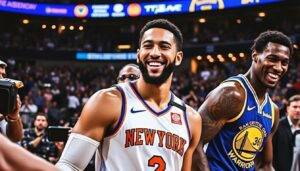Kuminga takes his time considering Warriors' offers

Jonathan Kuminga, the rising star of the Golden State Warriors, is in no rush to accept the current contract offers laid out by the team. Despite the Warriors’ persistent attempts to lock him down for a fifth season, Kuminga's cautious approach has stalled negotiations, leaving his future—and much of the Warriors’ offseason moves—hanging in the balance. This deadlock underscores a growing tension between the athlete’s ambition for a bigger role and the team’s cautious salary demands amid an icy market for restricted free agents across the NBA.
Why Kuminga’s Contract Negotiations With Warriors Could Drag Into The Season
Since the start of free agency, Kuminga has been deliberate, refusing to settle for any of the Warriors’ offers. After his recent workout in Miami, he told ESPN’s Shams Charania that he hasn’t found anything tempting enough to sign yet. The Warriors’ front office, led by GM Mike Dunleavy, believes they’ve put forth a fair proposal that acknowledges Kuminga’s contributions and potential. Yet, Kuminga remains unmoved.
This stalemate is also a product of the Warriors’ reluctance to absorb players with bad salaries in trade packages. Their demands in sign-and-trade talks include a first-round pick, which many teams like Phoenix and Sacramento cannot meet. Thus, despite active talks, no concrete trade offers have materialized.
Key points on why Golden State’s off-season activities are on hold:
- Warriors are the only NBA team yet to sign or trade a player this summer.
- The restricted free agent market is cold due to limited salary cap space around the league.
- Warriors demand a first-round pick for Kuminga in any sign-and-trade, a deal that’s hard to execute.
- Kuminga’s camp continues exploring opportunities outside Golden State.
Kuminga’s Options and The Warriors’ Strategy Moving Forward
With a one-year, $7.9 million qualifying offer still on the table through October 1, Kuminga faces a critical decision juncture. Accepting this offer means taking less money immediately but gaining unprecedented control over his career with a no-trade clause and an expiring contract. This could be a savvy move in today’s unpredictable NBA landscape but also signals his unwillingness to be pigeonholed as a secondary option.
Golden State’s hesitation to finalize other roster moves until Kuminga's situation is resolved reflects their attempt to maintain salary flexibility. Meanwhile, the team is targeting veteran bench pieces like Al Horford, De’Anthony Melton, and Seth Curry to shore up depth—a sign they’re preparing contingencies should negotiations collapse.
- Warriors eye veteran center Al Horford as a potential stretch shooter to boost frontcourt spacing.
- De’Anthony Melton, despite an ACL injury last season, has impressed and fits well alongside Steph Curry.
- Seth Curry offers shooter depth and a family connection that appeals to the Warriors’ culture.
With Kuminga’s role being a sticking point—he desires a guaranteed starting role and consistent minutes—the Warriors must weigh his potential impact on their championship plans against the risk of losing leverage in negotiations. His impressive playoff performances, including multiple 20+ point games, have proven his scoring potential when given the chance.
How Kuminga’s Standoff Reflects Broader NBA Contract Trends In 2025
The Kuminga saga is emblematic of a wider phenomenon affecting NBA restricted free agents this summer. Across the league, players are demanding greater security and clearer roles, while teams are constrained by tight salary caps following major contracts signed by superstars like Steph Curry and Jimmy Butler.
These dynamics have driven an unusually chilly market for restricted players. Teams are more cautious, the salary cap is tighter than in recent years, and players like Kuminga are ready to push boundaries to avoid getting stuck on the bench or as fallback options.
Consider the landscape of top free agents in 2025—this year’s draft class, notable trades, and big signing decisions all hint that teams must be more strategic than ever, balancing the need for young talent with financial prudence.
- Restricted free agents across the NBA face limited suitors due to cap constraints.
- Teams prioritize draft assets and young promise over risky contracts.
- Players like Kuminga seek larger roles over mere contract value.
- Golden State’s handling of Kuminga will signal how the Warriors plan to maintain competitiveness.
What This Means For Fans And The Warriors’ Future
Fans of the Warriors should brace for continued uncertainty around Kuminga’s status, which has ripple effects on the team’s chemistry and ability to sign complementary pieces. The situation reflects how cutting-edge NBA sports negotiations have evolved, with players wielding more control and teams forced to navigate complex financial landscapes.
Still, Kuminga’s refusal to rush highlights a self-awareness uncommon to many young athletes. The gamble he takes could redefine his trajectory, from an underutilized talent to a bona fide star with a clear, central role—or risk stagnation if miscalculated.
- Kuminga pushes for a guaranteed starting role and consistent playing time.
- Warriors must balance retention of talent with maintaining salary cap flexibility.
- Further roster moves will depend heavily on the outcome of these negotiations.
- Steph Curry and veteran leaders remain critical to mentoring young talents like Kuminga.
For those following the NBA’s evolving contract drama, Kuminga’s case is one to watch throughout the summer, promising drama that extends well into the pre-season. More about the Warriors’ current dynamics and player updates can be found in recent reports on their recent games and Kuminga’s rise.

